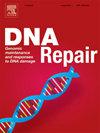The differential roles of rad9 alternatively spliced forms in double- strand DNA break repair during Drosophila meiosis
IF 2.7
3区 生物学
Q2 GENETICS & HEREDITY
引用次数: 0
Abstract
The 9–1–1 complex, comprising the Rad9, Hus1 and Rad1 proteins, is believed to operate as a component of a DNA damage checkpoint pathway. Our initial analysis of the Drosophila hus1 gene showed that Hus1 plays a dual role in meiosis, regulating both meiotic DNA damage checkpoint and homologous recombination repair. In this study, we further analyzed the meiotic roles of another protein in the complex, Rad9, which has two alternatively spliced forms, Rad9A and Rad9B. Using CRISPR/Cas9, we generated flies mutant for both rad9 isoforms. We found that, similarly to hus1, mutations in rad9 lead to female sterility. Also, double-strand DNA breaks (DSBs) that form during meiosis are not processed efficiently, and the DNA within the oocyte nucleus fails to form its characteristic shape in rad9 mutants. On the other hand, the hus1 mutation completely disrupts checkpoint activation in DSB repair enzyme mutants, whereas the rad9 mutation only partially impairs checkpoint activation in this context. Moreover, spatial rescue experiments revealed that Rad9B is efficient in repairing meiotic DSBs, while Rad9A is not. Furthermore, we found that female fertility in rad9 mutants depends on early efficient meiotic DSB repair but not on karyosome formation. In summary, our results demonstrate a differential role of Rad9 alternatively spliced forms during Drosophila meiosis in oogenesis, and while former studies showed that Hus1 is sufficient for the effective activation of the meiotic recombination checkpoint, our results revealed that this is not true for Rad9.
果蝇减数分裂过程中rad9选择性剪接形式在双链DNA断裂修复中的不同作用
9-1-1复合体由Rad9、Hus1和Rad1蛋白组成,被认为是DNA损伤检查点通路的一个组成部分。我们对果蝇hus1基因的初步分析表明,hus1在减数分裂中起双重作用,既调节减数分裂DNA损伤检查点,又调节同源重组修复。在这项研究中,我们进一步分析了该复合体中另一种蛋白Rad9的减数分裂作用,该蛋白有两种选择性剪接形式,Rad9A和Rad9B。利用CRISPR/Cas9,我们产生了两个rad9亚型的果蝇突变体。我们发现,与hus1类似,rad9的突变会导致女性不育。此外,在减数分裂过程中形成的双链DNA断裂(DSBs)不能有效地加工,并且在rad9突变体中卵母细胞核内的DNA不能形成其特征形状。另一方面,在DSB修复酶突变体中,hus1突变完全破坏检查点激活,而rad9突变在这种情况下仅部分损害检查点激活。此外,空间救援实验表明,Rad9B对减数分裂dsb具有有效的修复作用,而Rad9A则没有。此外,我们发现rad9突变体的雌性生育能力取决于早期有效的减数分裂DSB修复,而不是核体的形成。总之,我们的研究结果表明,在果蝇卵发生过程中,Rad9的选择性剪接形式在果蝇减数分裂过程中具有不同的作用,尽管之前的研究表明,Hus1足以有效激活减数分裂重组检查点,但我们的研究结果表明,Rad9并非如此。
本文章由计算机程序翻译,如有差异,请以英文原文为准。
求助全文
约1分钟内获得全文
求助全文
来源期刊

DNA Repair
生物-毒理学
CiteScore
7.60
自引率
5.30%
发文量
91
审稿时长
59 days
期刊介绍:
DNA Repair provides a forum for the comprehensive coverage of DNA repair and cellular responses to DNA damage. The journal publishes original observations on genetic, cellular, biochemical, structural and molecular aspects of DNA repair, mutagenesis, cell cycle regulation, apoptosis and other biological responses in cells exposed to genomic insult, as well as their relationship to human disease.
DNA Repair publishes full-length research articles, brief reports on research, and reviews. The journal welcomes articles describing databases, methods and new technologies supporting research on DNA repair and responses to DNA damage. Letters to the Editor, hot topics and classics in DNA repair, historical reflections, book reviews and meeting reports also will be considered for publication.
 求助内容:
求助内容: 应助结果提醒方式:
应助结果提醒方式:


